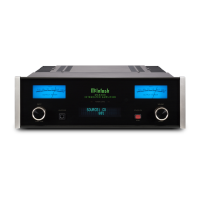25
justing the volume control will un-mute the MA5200.
Headphones Jack
Connect a pair of dynamic headphones to the Head-
SKRQHV-DFNZLWKD´PPVWHUHRSKRQHW\SH
plug for private listening. Use the TRIM Output Mode
to mute the Loudspeakers. Refer to figure 50 and
“OUTPUT MODE” on page 23.
Note: The Headphone Output is optimized for imped-
ances ranging from 20 to 600 ohms.
Power Output Meters
The MA5200 Power Output Meters indicate the power
delivered to the Loudspeakers. Refer to figure 69.
The meters respond to all the musical information
being produced by the Amplifier. They indicate to an
accuracy of at least 95% of the power output with only
a single cycle of a 2,000Hz tone burst.
3RZHU*XDUG
During normal operation, the Front Panel Power
Guard Indicators will momentarily illuminate during
peaks in the audio signals. In the event the MA5200
over heats, due to improper ventilation, high ambient
temperature and/or impedance mismatch, the inter-
nal protection circuits will activate. The Front Panel
Power Guard Indicators will continuously illuminate
and the audio will be muted. When the MA5200 has
returned to a safe operating temperature, normal op-
eration will resume.
Using a Separate Power Amplifier
To use a separate amplifier instead of the MA5200
built-in Power Amplifier, connect the Loudspeakers to
the separate power amplifier and remove the McIn-
tosh Jumpers that are located between the PRE AMP
OUTPUTS Jacks and the PWR AMP INPUT Jacks.
Connect an audio cable betweeen the separate Power
Amplifier input jacks and the PRE AMP OUTPUTS
Jacks on the MA5200. Refer to figures 70 and 71.
Note: The Output Power Meters on the Front Panel of
the MA5200 will no longer indicate Power Output.
Refer to Power Output Indicators on the connected
separate Power Amplifier instead.
Passthru
When the MA5200 is connected together with a Mc-
Intosh Multichannel A/V Control Center or Surround
After approximately 5 seconds the Display returns to
indicate the Source Selection and Volume Level.
Notes: 1. For information on how the Front Panel
Display Brightness can change with the Meter
Illumination On/Off Setting, refer to page 24
“Display Brightness”.
2. Meter Illumination of recent McIntosh Power
Amplifiers will also switch On/Off when con-
nected to the MA5200 via a power control cable.
Trim
Press the Front Panel INPUT/TRIM Control to acti-
vate the MA5200 Trim Functions. Rotate the Front
Panel INPUT/TRIM Control to select the desired Trim
Function and then rotate the VOLUME/ADJUST Con-
trol to vary or make changes. Refer to figure 50. The
Remote Control TRIM and LEVEL +/- Push-buttons
may also be used. Approximately 5 seconds after Trim
Function Selection and/or adjustments have stopped,
the MA5200 will switch off the Trim Mode.
Mute
Press the MUTE Push-button on the Remote Control
to Mute the Audio in the Loudspeakers, PRE AMP
Output Jacks and the Headphones. The Front Panel
Display will indicate the Source Name and with the
word MUTE in place of the actual volume setting.
Refer to figure 68.
Pressing the Mute Push-button a second time or ad-
How to Operate the MA5200, con’t
Figure 67
METER BACKLIGHT
Lights: Off
Figure 68
SOURCE: CD
MUTE
Figure 69
Jumpers
Figure 70
Figure 71
7R6HSDUDWH3RZHU$PSOL¿HU

